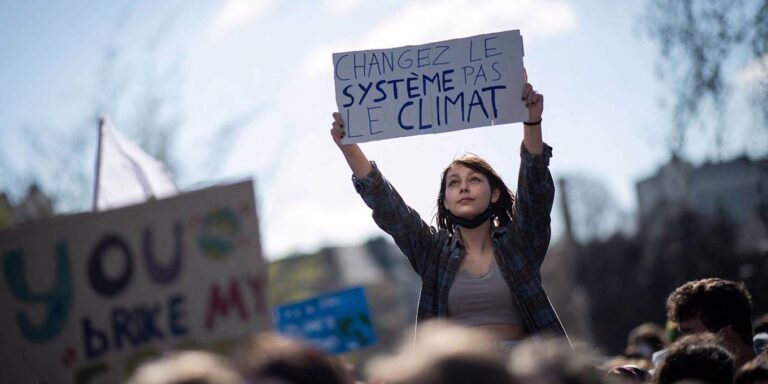Debunking Solar Geoengineering

Proponents of solar geoengineering say that lowering Earth’s average temperature by reflecting sunlight into space will tackle global warming. But if we are to avoid a climate catastrophe, there is no substitute for phasing out fossil fuels.
BERLIN – As climate chaos threatens the Global North and the lifestyles of the world’s richest people, we might expect to hear elites demand a rapid exit from reliance on fossil fuels. Instead, a controversial idea is coming to the fore: dimming the sun. Advocates claim that through science fiction-like methods, known as solar geoengineering, we can dial down the planet’s thermostat by decreasing the amount of energy that reaches the atmosphere. The idea has gained enough traction for rich philanthropists to notice and for the White House to fund research. There’s just one problem: it’s a recipe for disaster.
One technological proposal currently making headlines is Stratospheric Aerosol Injection (SAI), with advocates claiming releasing aerosols into the upper atmosphere and bouncing sunlight back into space would reduce surface temperatures. This idea is gaining traction at a time when some contend that we should be working on a plan B because it is too late to limit global warming to 1.5° Celsius as agreed in the 2015 Paris climate agreement. But giving up this ambition would be a gift to carbon polluters, as International Energy Agency Executive Director Fatih Birol recently explained, and the notion that solar geoengineering could ever be a plan B is false and dangerous.
Experts have repeatedly debunked the idea that we can “control” the earth’s thermostat. The world’s foremost authority on climate science, the Intergovernmental Panel on Climate Change, has warned that solar geoengineering is not a credible solution. Climate models show that masking global heating with sunlight reduction could bring massive changes in atmospheric circulation and alter rainfall patterns – such as the monsoon – with especially pronounced effects in countries that are already experiencing increasingly severe and frequent storms, droughts, fires, and other climate-related events.
To work, solar geoengineering technologies like SAI would require unprecedented international cooperation. Governments would need to align to get chemical-spraying airplanes off the ground, for example, implying that only powerful countries or military regimes could provide the necessary infrastructure. Chemical mining and production would require additional infrastructure on a massive scale. And all of this would need to be sustained for decades or longer. If a new government stopped an aerosol injection program after regime change, it could trigger a “termination shock” that sent global temperatures soaring, in line with existing greenhouse-gas levels in the atmosphere.
Despite this, Harvard University is set to test the equipment associated with SAI in the context of a controversial research project. But this method is effectively ungovernable. That is why hundreds of academics are calling for a Solar Geoengineering Non-Use Agreement to block public funds for the technology, ban outdoor experiments, patenting, and deployment, and to counter support in international fora and policy discussions.
In addition to the technological and political limitations, prominent lawyers say solar geoengineering is at odds with international human rights and environmental law. If geoengineering changes weather patterns, it could infringe on people’s rights to life, health, and a livelihood. Moreover, SAI could violate the legal duty to avoid causing transboundary environmental harm. A technology set to impact the climate on the global scale would also require everyone potentially affected to have a say – an impossible idea.
But if we know these schemes won’t work, are full of risks, cannot be tested or governed, and delay near-term climate action, why are we seeing increased momentum and support for them? Put simply, they give big polluters a get-out-of-jail-free card and allow them to patent and profit from the relevant technologies and associated infrastructures.
Oil and gas companies have been researching and patenting (solar and other) geoengineering technologies for decades. In fact, most solar geoengineering models rely on large-scale deployment of Carbon Dioxide Removal to deal with the continued production and combustion of fossil fuels. Proponents of CDR offer carbon removal offsets to polluters, undermining long-term solutions and exacerbating the climate emergency. Worryingly, calls for CDR gained momentum at this year’s COP27, which risks blowing a massive hole in the Paris agreement.
While geoengineering supporters often say it is in the interest of the disadvantaged Global South, the Global South isn’t buying it. In fact, most groups in the global climate movement reject solar geoengineering entirely. Indigenous communities have rallied against solar geoengineering experiments in places such as Alaska and Sweden. In reality, it is the richest and most polluting countries (especially the United States) that are researching and funding these technologies.
Once the world awakens to the reality that there is no quick fix to remove carbon from the atmosphere and no substitute for a rapid phaseout of fossil fuels, solar geoengineering might gain undeserved credibility as a last-ditch option – full of risks but supposedly without alternative. We must not allow that scenario to come true.
This means that we must not allow it to become normalized through policy debates, private initiatives, government proposals, and research. The science is clear: We can still prevent irreversible harms to ecosystems and human rights. But the only way to avoid further climate disasters is real climate action now. We must accelerate the transition away from fossil fuels – and leave the science fiction on the shelf.